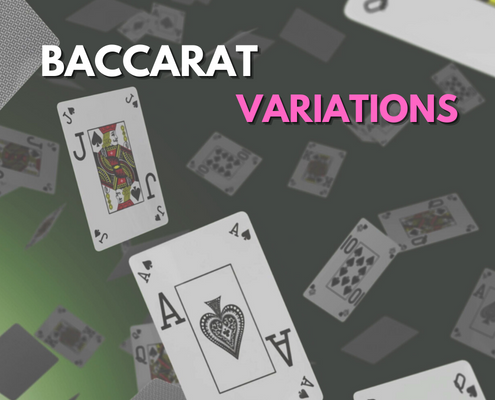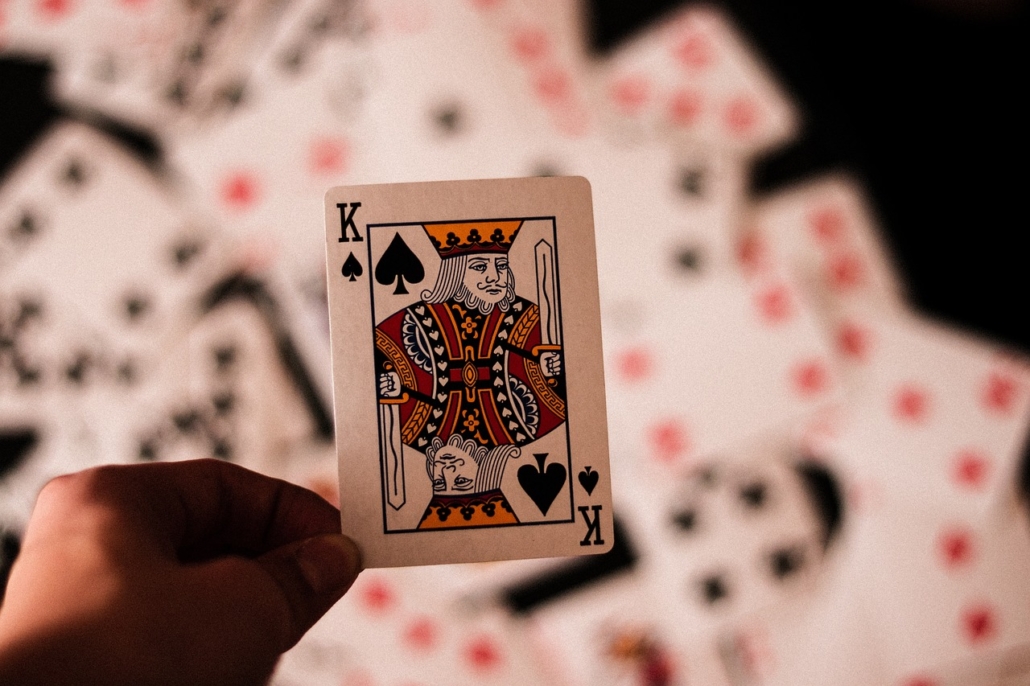Baccarat Variations and Improve Your Odds of Winning: A Guide for South African Players
Table of Contents
The Classic Baccarat Variation
The origins of classic baccarat can be traced back to 15th century Italy, where it was played by the aristocracy. It was later introduced to France, where it became popular among the nobility and was referred to as “Chemin de Fer.”
In the 1950s, baccarat was introduced to Las Vegas casinos, where it quickly became popular among high rollers. Today, it remains a popular casino game around the world and is often featured in movies and TV shows as a symbol of high-class gambling.
Classic baccarat is a casino card game that is played with six to eight decks of cards. The goal of the game is to correctly predict which of two hands, the banker’s hand or the player’s hand, will have a total value closest to nine. Aces count as one, numbered cards are their face value, and face cards count as zero.
At the beginning of each round, players can bet on either the player or banker hand, or a tie. After the bets are placed, both the player and banker are dealt two cards each. The hand that has a total value closest to nine wins the round.
If the total value of a hand exceeds nine, then the first digit of the total is dropped, and the remaining number represents the value of the hand. For example, a hand with a total value of 15 would have a value of five.
If the initial two cards dealt to either the banker or player total eight or nine, this is called a “natural,” and the round is over. If neither hand has a natural, then additional cards may be drawn according to a set of predetermined rules.
Basic Strategy and Tips for Winning at Classic Baccarat:
One of the key strategies in classic baccarat is to bet on the banker’s hand, as it has a slightly higher chance of winning. It is also important to have a clear understanding of the rules and odds of the game before placing any bets.
Another strategy is to bet consistently and not to change betting patterns mid-game, as this can be a sign of a player who is counting cards or using other tactics to gain an advantage.
It is also important to set a budget before playing, as baccarat is a high-stakes game and can quickly lead to significant losses if not managed carefully.
Mini Baccarat
Mini Baccarat has a high Return to Player (RTP) of around 98.76%, with a low house edge of typically around 1.2%. The rules and gameplay of Mini Baccarat are similar to classic Baccarat, with the objective of the game being to predict which hand, the player or the banker, will have a total closer to 9. Players can bet on either the player, banker, or a tie.
The game starts with each player placing their bet on the player, banker, or tie. Two cards are then dealt to both the player and the banker. The values of the cards are added up, and the hand with the highest value closest to 9 wins. The banker hand has a slightly higher chance of winning than the player hand, so it is generally recommended to bet on the banker. However, keep in mind that there is a commission fee for betting on the banker, which can cut into your profits.
Another tip is to avoid betting on a tie, as the odds of a tie occurring are relatively low. Additionally, it is crucial to manage your bankroll and only bet what you can afford to lose.
Differences between Punto Banco and other baccarat variations
The game is typically faster-paced than traditional Baccarat. Here are the differences between Mini Baccarat and other Baccarat variations:
- Classic Baccarat: In Classic Baccarat, the game is typically played in a separate room or area of the casino, with high minimum bets. The players take turns dealing the cards, whereas in Mini Baccarat, the dealer handles all the cards. Also, in Classic Baccarat, there are usually three dealers, whereas in Mini Baccarat, there is only one.
- Chemin de Fer: Chemin de Fer is another popular variation of Baccarat. In Chemin de Fer, the players take turns being the banker, and the other players bet against the banker. In Mini Baccarat, there is no player banking option, and the dealer always acts as the banker.
- Baccarat Banque: Baccarat Banque is similar to Chemin de Fer, where the players take turns being the banker. However, in Baccarat Banque, the banker is responsible for covering all bets made against them. In Mini Baccarat, the dealer is the only banker and takes all the bets.
- EZ Baccarat: EZ Baccarat is a variation of Baccarat that eliminates the commission charged on banker bets. In EZ Baccarat, players can make the Dragon 7 or Panda 8 side bets, which offer higher payouts. These side bets are not available in Mini Baccarat.
Chemin de Fer
Chemin de Fer is a variation of Baccarat that originated in France. It is played with six decks of cards and is usually played by up to 12 players. The game is similar to Baccarat, but there are a few key differences.
In Chemin de Fer, players take turns being the banker and deal the cards. The objective of the game is to predict which hand, the player or the banker, will have a total closer to 9. Players can bet on either the player, banker, or a tie.
The game starts with each player placing their bet on the player, banker, or tie. The banker then deals two cards to each player and to themselves. The values of the cards are added up, and the hand with the highest value closest to 9 wins.
The house edge for Chemin de Fer is relatively low, typically around 1.06%, which makes it an attractive game for players who want to maximise their chances of winning. The RTP of Chemin de Fer is around 98.94%, which means that for every R100 bet, the player can expect to receive R98.94 in winnings.
For example, if a player places a R500 bet on the banker and wins, they will receive R500 in winnings, minus the commission fee of around 5%, which would be R25. The total payout would be R475.
Another tip is to avoid betting on a tie, as the odds of a tie occurring are relatively low. Additionally, it is crucial to manage your bankroll and only bet what you can afford to lose.
Differences between Chemin de Fer and other baccarat variations
Firstly, unlike in other variations of Baccarat, in Chemin de Fer, players take turns being the banker, rather than the house or casino always being the banker. Players have the option to pass on being the banker, and if no one wants to be the banker, the house or casino will take over.
Secondly, in Chemin de Fer, players have the option to bet on other players’ hands, rather than just the banker and player hands. This adds a new layer of complexity and strategy to the game, as players must decide which hand they believe will win while also considering the possibility of other players betting on their hand.
Another significant difference in Chemin de Fer is that the banker is not required to bet on the banker’s hand. In other versions of Baccarat, the banker is required to bet on their hand. However, in Chemin de Fer, the banker can choose to bet on any hand, including the player’s hand.
Finally, in Chemin de Fer, the shoe, which holds the cards, is passed around the table, rather than remaining with the dealer. This means that players have the opportunity to handle the shoe and deal the cards, adding a more interactive element to the game.
Punto Banco
Punto Banco has a Return to Player (RTP) of around 98.94%, with a low house edge of typically around 1.06%. The rules and gameplay of Punto Banco are similar to classic Baccarat and Mini Baccarat, with the objective of the game being to predict which hand, the player or the banker, will have a total closer to 9. Players can bet on either the player, banker, or a tie.
The game starts with each player placing their bet on the player, banker, or tie. Two cards are then dealt to both the player and the banker. The values of the cards are added up, and the hand with the highest value closest to 9 wins. The banker hand has a slightly higher chance of winning than the player hand, so it is generally recommended to bet on the banker. However, keep in mind that there is a commission fee for betting on the banker, which can cut into your profits.
Another tip is to avoid betting on a tie, as the odds of a tie occurring are relatively low. Additionally, it is crucial to manage your bankroll and only bet what you can afford to lose.
Differences between Punto Banco and other baccarat variations
One of the main differences between Punto Banco and other Baccarat variations is that Punto Banco is played with six to eight decks of cards, whereas other Baccarat variations may be played with as few as one deck. This makes Punto Banco a higher-stakes game than other Baccarat variations.
Another difference is that in Punto Banco, the casino always plays the role of the banker. In other Baccarat variations, such as Chemin de Fer, players take turns being the banker, and in Baccarat Banque, one player is always the banker.
Overall, Punto Banco is an exciting and fast-paced game that offers plenty of opportunities to win big.
Super 6
Super 6 Baccarat is a variation of Baccarat that is popular in South Africa. It is similar to traditional Baccarat, but with a few key differences. One of the primary differences is that in Super 6 Baccarat, a winning Banker hand pays out at odds of 0.5:1 instead of the usual 1:1.
The Return to Player (RTP) for Super 6 Baccarat is around 85.6%, and the house edge is relatively high at 4.2%. The minimum bet for Super 6 Baccarat in South Africa is usually around R50, but this can vary depending on the casino.
The objective of the game is to predict which hand, the player or the banker, will have a total closer to 9. Players can also bet on a tie or the Super 6 side bet. The Super 6 side bet is a bet on the banker winning with a total of six and pays out at odds of 15:1.
The game starts with each player placing their bet on the player, banker, tie, or Super 6 side bet. Two cards are then dealt to both the player and the banker. The values of the cards are added up, and the hand with the highest value closest to 9 wins. If the Banker hand wins with a total of 6, the Super 6 side bet wins.
It is generally recommended to avoid betting on the tie as it has a high house edge. It is also important to manage your bankroll and only bet what you can afford to lose.
Differences between Super 6 and other baccarat variations
One of the primary differences is that a winning Banker hand in Super 6 Baccarat pays out at odds of 0.5:1 instead of the usual 1:1. This means that if a player bets on the Banker and wins, they will receive half their original bet in winnings, rather than the full amount.
In addition to this, Super 6 Baccarat also offers a side bet called the Super 6, which is a bet on the Banker hand winning with a total of six. This side bet pays out at odds of 15:1, providing an additional opportunity for players to win big.
The gameplay in Super 6 Baccarat is also slightly different from traditional Baccarat. The objective of the game is to predict which hand, the player or the banker, will have a total closer to 9. However, the payout for the Banker hand is different, and there is also the Super 6 side bet available.
Analytical Thinking in Baccarat
Analytical thinking is like the secret weapon to improving your odds of winning at baccarat. It’s like a pair of night vision goggles that help you see the game in a new light. By using analytical thinking, you can evaluate the odds and make more informed decisions when placing bets.
To develop analytical thinking skills while playing baccarat, you need to be like a detective, looking for clues in the game. Keep track of the cards that have been dealt, observe the betting patterns of other players, and analyse the odds of different bets. It’s like trying to crack a case and find the winning solution.
Another tip for developing analytical thinking skills in baccarat is to be like a zen master, staying focused and avoiding distractions. This will allow you to stay engaged in the game and pick up on important details that could impact your betting decisions. It’s like finding your inner peace and unlocking your hidden potential.
Real-life examples of analytical thinking in baccarat include being like a fortune teller, keeping track of the outcomes of previous hands, looking for patterns or trends in the cards that have been dealt, and using that information to inform your betting decisions. Additionally, by analyzing the odds of different bets and evaluating the potential payouts, you can be like a savvy businessperson, making smart decisions that are based on logic and reason.
Overall, analytical thinking is like having a secret weapon in your back pocket that can help you increase your chances of winning at baccarat. By being like a detective and a zen master, and using real-life examples like a fortune teller and a savvy businessperson, you can improve your analytical thinking skills and take your baccarat gameplay to the next level.
Conclusion
In conclusion, baccarat is an exciting and fast-paced game that offers plenty of opportunities to win big. By understanding the rules and basic strategy, players can increase their chances of success and enjoy the game to its fullest. Additionally, by developing analytical thinking skills and paying attention to the details of the game, players can improve their odds of winning and make more informed betting decisions.
At ZAR Casino, players can enjoy a range of baccarat games, including Super 6 Baccarat. With the opportunity to win big and the convenience of playing from the comfort of your own home, there’s never been a better time to try your luck at baccarat.
So why not take a chance and try your hand at baccarat today? With the tips and advice provided, and your newly developed analytical thinking skills, you can increase your chances of success and take your gameplay to the next level. Head over to ZAR Casino now and start playing baccarat online!
FAQs
What is the history of baccarat in South Africa?
Baccarat has been a popular game in South Africa for many years, with many of the major casinos offering baccarat tables. The game is believed to have originated in Italy and was introduced to South Africa by European settlers.
What are the popular baccarat variations in South African casinos?
Some of the popular baccarat variations in South African casinos include Super 6 Baccarat, Mini Baccarat, and Chemin de Fer. These variations offer different rules and features that make the game more interesting and exciting.
Is baccarat legal in South Africa?
Yes, baccarat is legal in South Africa and can be played at licensed land-based casinos. However, online gambling is currently illegal in South Africa.
How can I play baccarat in South Africa?
To play baccarat in South Africa, you will need to visit a licensed land-based casino. Many of the major casinos in the country offer baccarat tables, with different variations available to suit different preferences.
What are the best baccarat strategies for South African players?
The best baccarat strategies for South African players include betting on the Banker hand, avoiding tie bets, and managing your bankroll effectively. It is also important to develop analytical thinking skills and pay attention to the details of the game, as this can help you make more informed betting decisions.




